|
Video: Lennart Nilsson's fetus photography
LEARN TO RECOGNIZE & UNDERSTAND THE MOST IMPORTANT LINES IN THE PALM OF YOUR HANDS! Since 1937 science knows that the 3 'primary palmar lines' start developing as early as the second and third embryonal month, and they form independently from the flexion movements of the hand (A. Wurth, 1937). This section will describe the role of the so-called 'volar pads' + how and when each of the five categories of hand lines starts developing. How do the hand lines develop in the fetal hand? A basic similarity between the hand lines and the fingerprints is that both are preceeded by the presence of 'volar pads' - these are temporary swellings (mesenchymal tissue) that rise around the 7th week in the hands and feet of the embryo. In the hand of the fetus exhibit the 'volar pads' rapid growth between 6.5 and 10.5 weeks. The hand of a 7 week old embryo (48 days). 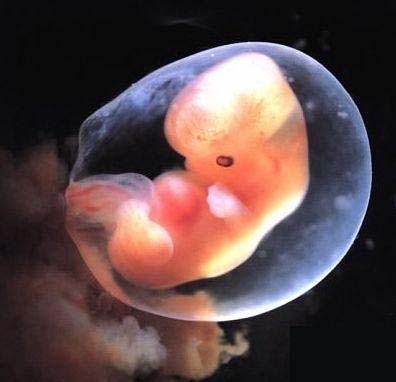
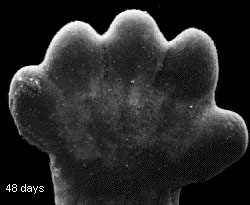
Initially the 'volar pads' appear as evenly rounded pads, however, by the 9th week, the pads begin to vary in both position and shape. Regression of the 'volar pads' takes place around week 10-11, which corresponds with the initial formation of epidermal ridge - the basic element of a fingerprint ridge. Researchers found that the size and shape of the fingertip 'volar pads' directly relates to the fingerprint pattern (high symmetrical 'volar pads' produce whorls; lower assymetrical 'volar pads' with normal heigh produce loops; and low 'volar pads' produce arches). A likewise process has been observed for the palm, where the 'volar pads' manifest in the interdigital regions. R.S. Bali (1994, p.84) wrote: "The base point fixation of primary creases of palm as well as of sole is of embryonic nature and their orientation in shape and size is pre-ordain manifestion of localised activity of volar pads." More details about the processes in the skin that preceed the development of the fingerprints & hand lines is presented by 'Ridges and Furrows' The hands of a 12 weeks old embryo. 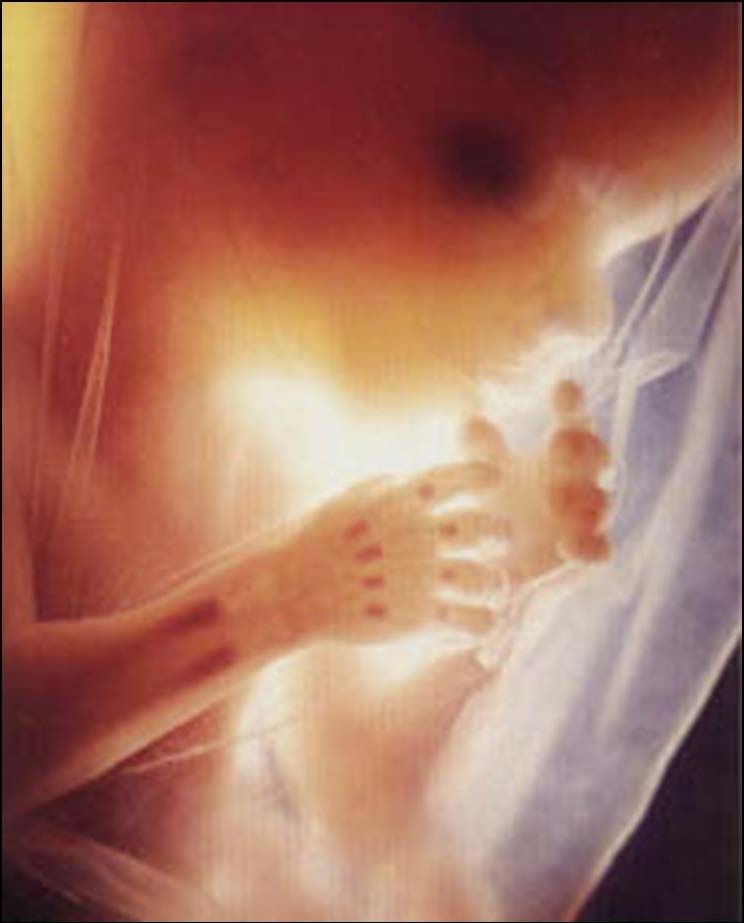
The hand of a 18 weeks old fetus. 
S. Kimura (1991) presented a detailed timeline scedual for the processes in the hand related to: the development of the 'volar pads' (Pads) & creases (Creases) of the hand, including: the finger creases (digit), 3 'primary palmar creases' (palm) and hand movement (flexion movement: + = spontaneous; ++ = tight grasping) - see the picture below. Timeline for embryologic hand development. 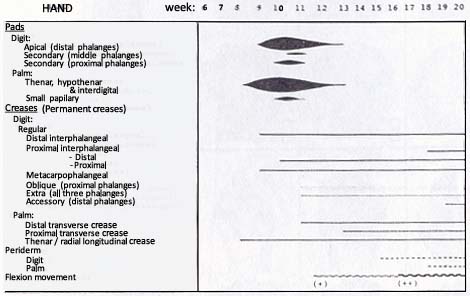
• 1 - Development of the 'primary palmar lines': life line, heart line & head line: Embryologic studies have shown that the development of the 'primary palmar lines' usually takes place in the following order - see also the picture below: 1 - a: the radial part of the life line (radial longitudinal crease in week 7-9*); 2 - b: the radial part of the heart line (distal transverse crease in week 9-12*); 3 - c: the ulnar part of the heart line; 4 - d: the head line (the proximal transverse crease in week 9-13*). * Due to difference in methodology varies the exact timing of the onset of the primary creases slightly among the reports of various researchers - e.g. R.S. Bali & D.K. Jain, 1983; S. Kimura & C. Kitagawa, 1986; B. Lacroix et.al, 1984; Pöpich & Smith, 1970; and C.A. Stevens et.al, 1986. Order of appearance in the 'primary palm creases' (H. Asano, 1985). 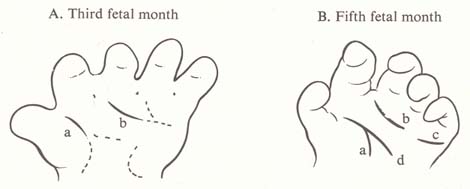
• 2 - Development of the 'palmar finger lines': The fate line makes its first appearance in the five month old foetus - while the same crease shows distinct shape of its own in the seven months old foetus. The other 'palmar finger lines' develop at a much later stage. • 3 - Development of the 'secundary palmar lines': Lunur lines and ulnar crease often manifest between the 7th month and the 8th month. Other 'secundary palmar lines' can manifest as well in the 8th month. • 4 - Development of the 'tertiary palmar lines': 'Tertiary palmar lines' show rapid growth during the 8th and 9th month. • 5 - Development of the 'accessory palmar lines': The 'accessory palmar lines' usually develop after birth. NOTICE: More details about which lines are included in the various categories is presented in the section: palmistry: an overview of the hand lines. In order to understand the basic characteristics of the human hand lines more properly you can now take a look at the formation of the hand lines in the hands of (human) apes and monkeys! ...more.
|
